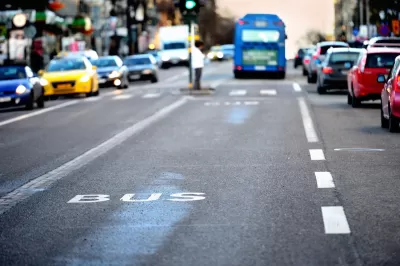Dedicated bus lanes on busy arterials can act as traffic calming mechanisms to reduce speeding.

A new study reveals that dedicated bus lanes have the additional benefit of improving overall road safety, writes Chris McCahill for State Smart Transportation Initiative.
In Albuquerque, a team of researchers found that traffic speeds dropped significantly along corridors with bus rapid transit (BRT) infrastructure, making it an “especially effective” tool to curb speeding. “The effects were largest at intersections along the BRT route and in places where the number of general-purpose lanes was reduced. Average vehicle speeds dropped by around 15% when there was a lane reduction, versus 10% at other locations, and 85th percentile speeds dropped by 12% to 14%, versus 8% at other locations.” The study notes that speeds did not change much on roads with the fastest posted speed limit (40 mph).
The authors add that other studies have shown similar effects from bike lanes, trees, and other design cues. The findings are important because major arterial roads are often inappropriate for typical traffic calming interventions. “Converting arterial corridors to more multimodal arrangements can provide road users with mobility options while simultaneously improving safety outcomes.”
FULL STORY: Dedicated bus lanes improve safety

Study: Maui’s Plan to Convert Vacation Rentals to Long-Term Housing Could Cause Nearly $1 Billion Economic Loss
The plan would reduce visitor accommodation by 25,% resulting in 1,900 jobs lost.

North Texas Transit Leaders Tout Benefits of TOD for Growing Region
At a summit focused on transit-oriented development, policymakers discussed how North Texas’ expanded light rail system can serve as a tool for economic growth.

Why Should We Subsidize Public Transportation?
Many public transit agencies face financial stress due to rising costs, declining fare revenue, and declining subsidies. Transit advocates must provide a strong business case for increasing public transit funding.

How to Make US Trains Faster
Changes to boarding platforms and a switch to electric trains could improve U.S. passenger rail service without the added cost of high-speed rail.

Columbia’s Revitalized ‘Loop’ Is a Hub for Local Entrepreneurs
A focus on small businesses is helping a commercial corridor in Columbia, Missouri thrive.

Invasive Insect Threatens Minnesota’s Ash Forests
The Emerald Ash Borer is a rapidly spreading invasive pest threatening Minnesota’s ash trees, and homeowners are encouraged to plant diverse replacement species, avoid moving ash firewood, and monitor for signs of infestation.
Urban Design for Planners 1: Software Tools
This six-course series explores essential urban design concepts using open source software and equips planners with the tools they need to participate fully in the urban design process.
Planning for Universal Design
Learn the tools for implementing Universal Design in planning regulations.
Ascent Environmental
Borough of Carlisle
Institute for Housing and Urban Development Studies (IHS)
City of Grandview
Harvard GSD Executive Education
Toledo-Lucas County Plan Commissions
Salt Lake City
NYU Wagner Graduate School of Public Service





























